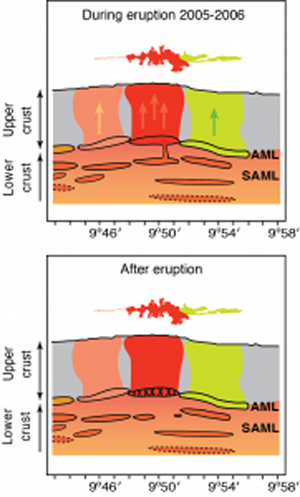
Two-thirds of earth’s surface is covered in oceanic crust, but the deep plumbing that generates new crust remains poorly understood. New images from a chain of volcanoes beneath the Pacific Ocean show that magma may be erupting from a multi-layered magma chamber extending two miles or more beneath the seafloor, far deeper than originally thought.
The pictures, in the latest issue of Nature Geoscience, may help resolve a debate about how new crust forms at mid-ocean ridges where earth’s tectonic plates are slowly pulling apart. In one hypothesis, the lower crust is formed as a shallow pool of magma beneath the volcanic spreading center solidifies, forming a kind of crystalline glacier that oozes down and out, like hot fudge over a sundae. In another view, pools of magma stacked vertically form new rocks at depths throughout the crust, and send lava to earth’s surface, creating the upper and lower crust in one fell swoop. The new images seem to support the multi-tier view, predicted by geologists who have studied eroded oceanic crust on land.
“We now see that during an eruption we may have magma moving from one level to another,” said study coauthor Suzanne Carbotte, a geophysicist at Columbia University’s Lamont-Doherty Earth Observatory.
The pictures come from a 2008 research expedition to the East Pacific Rise, a chain of submarine volcanoes that run from California’s Salton Sea to the northern shores of Antarctica. Aboard the R/V Langseth, the scientists used pulses of sound to map the sub-seafloor beneath a region that saw massive eruptions from 2005 to 2006. In the sub-surface images, Carbotte and former Lamont graduate student Milena Marjanovic and others on the cruise recognized multi-layered magma pools, or “melt lenses,” stacked one on top of the other. In addition, these multiple tiers looked as if they had been connected during the eruption.
A multi-tier magma chamber had been predicted in 1998 by Lamont-Doherty geophysicist Peter Kelemen and colleagues based on field observations in the Middle Eastern nation of Oman, where mantle peridotites formerly at the bottom of the ocean have been heaved onto land, providing easy access. Kelemen and colleagues discovered that rocks in close proximity had different chemical signatures. That would be impossible if a slow-oozing crystalline mush had created them. To Kelemen, Oman’s uneven but undeformed rock layers, too, seemed inconsistent with such a model.
“We could identify some bodies of rock that surely had formed in deeper melt lenses within the uppermost mantle, and we showed that they were very similar to the rocks throughout the crust,” said Kelemen, who was not involved in the Nature Geoscience study.
“We hoped that someday techniques would improve and the deeper lenses would emerge from their obscurity,” he added. “With the dedication and hard work of many research teams, this finally seems to be happening.”
More information:
“A multi-sill magma plumbing system beneath the axis of the East Pacific Rise” Nature Geoscience (2014) DOI: 10.1038/ngeo2272
Note : The above story is based on materials provided by Columbia University









